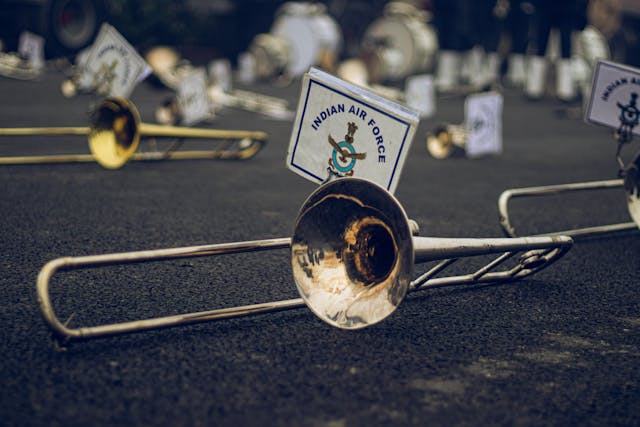
How do trombones work? Trombones and all brass instruments use different methods, but they all make a variety of sounds by altering the length of the tube the air travels through.
All wind instruments generally work on the same principle, although they have some major differences. The general idea is that you blow into one end of the instrument, which makes it vibrate, and the sound comes out the other end. You can use the keys or cover the holes along the instrument to vary the length of the tube and alter the pitch of the vibration, altering the sound of the note. Obviously, woodwind and brass instruments are different. Woodwind instruments need to have a reed in the mouthpiece of the instrument because this is what makes the air vibrate and produces the sound. Brass instruments don’t have a reed and the player makes the vibration by vibrating their lips when they blow. Woodwind instruments, being made of wood, don’t vibrate as much as brass instruments do, which means brass instruments can generally be louder. Brass instruments also usually have a cone at one end, which amplifies the sound a lot.
A trombone is two U-shaped tubes that interlock and are free to move. Each of the two U-shaped tubes has parts that detach so it can be disassembled and cleaned. The front of the two tubes is free to slide forwards and backwards. The rear of the two tubes has the bell, which is the part that amplifies the sound. There is a brace across from the tube with the bell on it that holds the mouthpiece. The tube with the bell and the mouthpiece on it rests on the shoulder and doesn’t move. The player uses their free hand to slide the slide forwards and backwards. To play, the musician vibrates their lips as they blow air into the mouthpiece. They slide the main slide forwards and backwards to make different notes.
So, how do trombones work? When the front slide of the trombone is pulled back, the two U-shaped tubes that make up the trombone are about 2.7 m long, depending on the type of trombone. When the front slide is fully extended, that changes to about 4 m. It is this difference in length that makes different notes. When the player vibrates their lips, the air entering the trombone tube vibrates. This vibration has a certain frequency, which gives it a certain pitch. By opening and closing their lips, the trombone player can adjust the pitch that comes out. However, the main way that the trombone player adjusts the pitch is by using the slide and increasing the length of the tube. When they blow into the trombone, they set all of the air in the tube vibrating. Each molecule hits the molecule next to it and passes the energy along the line until it comes out of the bell and is magnified. The speed of the energy passing along the tube is the pitch that we hear. If the energy moves very quickly, we hear it as a high pitch and if it moves very slowly, we hear it as a low pitch. When the slide is pulled back and the tube is at its shortest, the energy passes very quickly along it to the bell and we hear it as a high pitched sound. If the trombone player extends the slide, it increases the length of the tube and more air flows in. The more air there is, the slower the energy passes through it to the bell and the lower the pitch. A shorter tube makes a higher sound and a longer tube makes a lower sound. With practice, the trombone player will learn what lengths of tube make what pitches and they can play music on it. Because the trombone slide moves to the point the player wants to play, rather than going there immediately, it gives the beautiful sliding sound that trombones are famous for.
All other brass instruments work in the same way. A trumpet is made of coils of brass tube and when you press the valves, they open or close different tubes, changing the length of the pipe, changing the frequency of the sound.
Trombones and all brass instruments are made of brass, obviously. That is because it is very easy to shape and it doesn’t rust. Brass instruments get wet from the air breathed into them and other metals might rust. You could make one out of stainless steel, but it wouldn’t resonate in the same way as a brass trombone does. The sound would be less rich. And this is what I learned today.
Try these next:
Sources
https://en.wikipedia.org/wiki/Trombone
https://newt.phys.unsw.edu.au/jw/brassacoustics.html
https://newt.phys.unsw.edu.au/jw/woodwind.html
https://en.wikipedia.org/wiki/Brass_instrument
https://www.lutherhigh.org/documents/arts/les_band/instrument_info/trombone_info.pdf
Photo by saikat ghosh: https://www.pexels.com/photo/trumpets-of-indian-air-force-12844059/

Pingback: Why are Stradivarius instruments good?